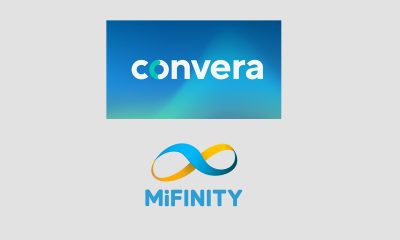Fintech PR
Visa B2B Connect Launches Globally

Visa Inc. (NYSE:V) today announced the commercial launch of the Visa B2B Connect network, giving financial institutions an ability to quickly and securely process high-value corporate cross-border payments globally.[1] The Visa B2B Connect launch will cover more than 30 global trade corridors, with an aim to expand to as many as 90 markets by end of 2019.
“Launching Visa B2B Connect marks an important industry milestone which will accelerate the evolution of how commercial payments move around the world,” said Kevin Phalen, SVP, global head of Visa Business Solutions. “By creating a solution that facilitates direct, bank to bank transactions, we are eliminating friction associated with key industry pain points. With Visa B2B Connect, we are making payments quicker and simpler, while enhancing transparency and consistency of data.”
Visa B2B Connect removes friction and time spent on cross-border corporate transactions by facilitating transactions from the bank of origin directly to the beneficiary bank. The network’s unique digital identity feature tokenises an organisation’s sensitive business information, such as banking details and account numbers, giving them a unique identifier that can be used to facilitate transactions on the network. Visa B2B Connect’s digital identity feature will transform the way information is exchanged in business-to-business cross-border transactions.
“It’s exciting to see the hard work of the combined teams come together for the commercial launch of Visa B2B Connect. Having participated in the pilot program, Commerce Bank is excited to see how this innovative solution will change the way cross-border payments are made, while increasing the speed and transparency for businesses around the world,” said Brian Gordon, SVP International Payments and Trade, Commerce Bank.
“As a pilot participant, we are excited about the Visa B2B Connect launch. This modern way of carrying out cross-border B2B payments will create a substantial added value for our corporate clients. Velocity, security and control of transactions, as well as lower counterparty risks are essential for a successful business with international partners,” said Alessandro Seralvo, director of Cornercard & executive vice president of Corner Bank.
Partners, including Bottomline, FIS and IBM are integral parts of the future scale of Visa B2B Connect. Bottomline and FIS are bringing Visa B2B Connect platform access to its participating bank clients. Along with Visa’s core assets, Visa B2B Connect utilises open source Hyperledger Fabric framework from the Linux Foundation, in partnership with IBM. This helps provide an improved process to facilitate financial transactions on a scalable, permissioned network.
“Bottomline is delighted to be working with Visa to accelerate the adoption of innovative ways for businesses to make faster cross-border payments,” said Rob Eberle, president & CEO, Bottomline. “Our ability to provide our mutual financial institution clients globally with access to Visa B2B Connect will help these banks to continue to deliver differentiated payment capabilities to their corporate customers.”
“Enabling modernisation for financial institutions across all payments systems is a key tenet of FIS’ global strategy, and we’re glad to be amongst Visa’s first partners to bring Visa B2B Connect platform access to our mutual clients at scale,” said Raja Gopalakrishnan, international head of Banking and Payments for FIS Global Financial Solutions.
“Working together on Visa B2B Connect, we are combining the strengths of the world’s leader in electronic payments with IBM’s recognised expertise in helping scale distributed ledger technology. This is a unique example of how blockchain-based architecture can help transform B2B value chains by facilitating secure and transparent transactions globally,” said Marie Wieck, general manager, IBM Blockchain.
“With Visa B2B Connect, we are leveraging Visa’s existing assets and our expertise in cybersecurity, data privacy, the scale of our network — and layering that with new elements of distributed-ledger technology to meet unique needs of this industry,” said Sam Hamilton, SVP, data product development at Visa. “This lays the foundation for a service with the potential to transform cross-border payments.”
SOURCE Visa
Fintech PR
Okto Becomes Go-To DeFi Trading App in Korea with Hyperliquid Spot & Futures Integration, HyperEVM launching soon

BANGALORE, India, April 23, 2025 /PRNewswire/ — Okto, the mobile frontend for Hyperliquid, has rapidly emerged as the preferred choice for Korean crypto investors, offering seamless access to Hyperliquid’s Spot and Futures markets — all within a single, self-custodial mobile interface. With deep liquidity, low slippage, and advanced trading infrastructure, Hyperliquid has become one of the most powerful decentralized trading venues. Okto acts as its mobile front end, combining CEX-like performance with the security and control of self-custody, allowing Korean traders to experience the full power of DeFi without friction.
“Korean investors are leading the next wave of DeFi adoption,” said Rohit Jain, Head of DeFi Initiatives at Okto. “The rise in perpetual and spot trading activity on the Hyperliquid-powered Okto app is proof that the region is embracing decentralized markets — not as an alternative, but as the future. With self-custody at the core and institutional-grade liquidity, Okto is helping redefine how Korean trades.”
Okto’s Futures trading went live in February 2024, followed by the recent launch of Spot trading — marking yet another major milestone in the app’s rapid evolution. “We envision Okto as the ‘Phantom’ of Hyperliquid — the most seamless and secure mobile gateway for decentralized trading,” said Rohit Jain. “As the leading mobile app for Hyperliquid, Okto was the first to integrate both Futures and Spot trading, and will soon be the first to bring HyperEVM assets and dApps directly to users. With this, we anticipate exponential growth in adoption over the next 2–3 years.”
Key Features:
- Hyperliquid-Optimized Design: Okto is tailored to integrate seamlessly with Hyperliquid’s advanced tools, allowing traders to manage their positions effortlessly across both spot and futures wallets. The one-click deposit feature to the Hyperliquid Spot wallet eliminates prior steps required for transactions on Hyperliquid.
- Cross-Chain Trading: With Okto’s powerful chain abstraction, users can seamlessly deposit and manage assets across 5+ blockchain networks — including Solana, Ethereum, Polygon, and more — all within a single app. Thanks to the Okto Layer, a robust middleware that abstracts away Web3 complexities, traders can now bring assets in and out of Hyperliquid with just one click. This unlocks true cross-chain trading at scale, maximizing opportunities without the friction of manual bridging or multiple wallets.
- Enhanced Security & Control: Okto offers a self-custodial wallet, providing users full control over their assets. Secure, gasless transactions and social login options enhance user convenience.
- Smart Notifications: Receive real-time alerts for price movements, trade execution, and market updates, ensuring traders never miss important opportunities.
- Optimized Mobile Experience: Designed with a mobile-first approach and CEX like experience, Okto eliminates friction in decentralized trading by offering real-time portfolio tracking and one-click cross-chain swaps, giving users greater flexibility.
Okto is revolutionizing mobile DeFi trading, making institutional-grade DEX trading accessible directly from users’ mobile devices. Whether a seasoned trader or a DeFi newcomer, Okto offers a secure, intuitive, and rewarding platform to access Hyperliquid’s full potential.
About Okto
The Okto ecosystem aims to simplify Web3 for everyone. At its core, it is a chain abstraction, and orchestration layer designed to simplify blockchain development. By offering web2-like modular APIs to help both new developers and experienced teams to build efficiently on the blockchain.
Okto ecosystem is experienced by 20Mn+ users while under development in the pre mainnet phase. Key components include the Okto Chain, Okto SDK, Okto wallet and Okto partners ecosystem.
Logo: https://mma.prnewswire.com/media/2625238/5179517/Okto_Logo.jpg
![]() View original content:https://www.prnewswire.co.uk/news-releases/okto-becomes-go-to-defi-trading-app-in-korea-with-hyperliquid-spot–futures-integration-hyperevm-launching-soon-302435299.html
View original content:https://www.prnewswire.co.uk/news-releases/okto-becomes-go-to-defi-trading-app-in-korea-with-hyperliquid-spot–futures-integration-hyperevm-launching-soon-302435299.html

Fintech PR
Investment of Approx. USD 4.5 Million in Development of Diagnostics for Tuberculosis to Partners Including Fujirebio and University Hospital Heidelberg
TOKYO, April 23, 2025 /PRNewswire/ — The Global Health Innovative Technology (GHIT) Fund announced today an investment of approximately JPY 679 million (USD 4.5 million1) for the development of diagnostics for tuberculosis, in addition to an investment of approximately JPY 15.9 million (USD 0.1 million1) for a drug discovery project for Chagas disease and leishmaniasis.2
Investment of approximately JPY 679 million (USD 4.5 million1) for the development of diagnostics for tuberculosis
Tuberculosis (TB) remains a serious infectious disease, with approximately 10.8 million cases and 1.25 million deaths reported in 2023, making it the leading causes of death from a single infectious agent.3 The United Nations’ Sustainable Development Goals (SDGs) set a target to end TB by 2030, but achieving this goal requires accurate and accessible diagnostic technologies. Current TB tests face challenges such as low sensitivity, high costs, complexity, and the need for specialized equipment and sputum samples, making them unsuitable for all patients. In particular, children, people with conditions who cannot produce sputum, and those in resource-limited settings often struggle to receive timely diagnoses, causing the continued spread of the disease. To address this issue, the GHIT Fund has decided to invest approximately JPY 679 million (USD 4.5 million1) towards a new TB diagnostic development project by US-based diagnostic developer Fluxus, Inc., 4 in partnership with Fujirebio, Inc., a developer of clinical diagnostics in Japan,4 and Heidelberg University Hospital in Germany.
This project will leverage Fluxus’ cutting-edge ultrasensitive detection technology to develop and validate a urine-based TB biomarker lipoarabinomannan (LAM) assay on its automated benchtop immunoassay analyzer. Additionally, the project will design and develop critical components for a portable, ultrasensitive point-of-care (PoC) system that integrates the urine LAM test. This advanced technology will enable rapid, accurate, and accessible diagnosis across a broader patient population, contributing to improved clinical outcomes and reduced transmission.
In addition, the GHIT Fund will invest approximately JPY 15.9 million (USD 0.1 million1) in a screening project against Chagas disease and leishmaniasis by Kitasato University, Nagasaki University, University of Tokyo, and Drugs for Neglected Diseases initiative (DNDi).
Please refer to Appendix 1 for detailed descriptions on these projects and their development stages.
As of March 31, 2025, the GHIT Fund has invested in 36 projects, including 15 discovery projects, 12 preclinical projects, and 9 clinical trials.5 The total amount of investments since 2013 is JPY 38.2 billion (USD 255 million1) (Appendix 2).
1 USD1 = JPY149.53, the approximate exchange rate on March 31, 2025.
2 These awarded projects were selected and approved as new investments from among proposals to RFP2023-002 and RFP2024-001 for the Product Development Platform and the Screening Platform, which were open for applications from June 2023 to July 2024.
3 WHO: https://www.who.int/news-room/fact-sheets/detail/tuberculosis
4 Fluxus, Inc. and Fujirebio, Inc. are members of Fujirebio.
5 This number includes projects in the registration phase.
The GHIT Fund is a Japan-based international public-private partnership (PPP) fund that was formed between the Government of Japan, multiple pharmaceutical companies, the Gates Foundation, Wellcome, and the United Nations Development Programme (UNDP). The GHIT Fund invests in and manages an R&D portfolio of development partnerships aimed at addressing neglected diseases, such as malaria, tuberculosis, and neglected tropical diseases, which afflict the world’s vulnerable and underserved populations. In collaboration with global partners, the GHIT Fund mobilizes Japanese industry, academia, and research institutes to create new drugs, vaccines, and diagnostics for malaria, tuberculosis, and neglected tropical diseases.
https://www.ghitfund.org/en
Appendix 1. Project Details
ID: G2023-204
|
Project Title |
Ultrasensitive Detection of Urine LAM for Point-of-Care Rapid Diagnosis of All Forms |
|
Collaboration Partners |
1. Fluxus, Inc. (USA) 2. Fujirebio, Inc. (Japan) 3. Heidelberg University Hospital (Germany) |
|
Disease |
Tuberculosis |
|
Intervention |
Diagnostics |
|
Stage |
Product Design, Product development |
|
Awarded Amount |
JPY 679,783,110 (USD 4.54 million) |
|
Status |
New project |
|
Summary |
[Project objective] To develop a prototype portable point-of-care (PoC) system and integrated ultrasensitive
[Project design] |
|
Project Detail |
https://www.ghitfund.org/investment/portfoliodetail/detail/240/en |
ID: S2024-122
|
Project Title |
Searching for Chagas disease therapeutic seed compounds from microbial cultures |
|
Collaboration Partners |
1. Kitasato University (Japan) 2. Nagasaki University (Japan) 3. University of Tokyo (Japan) 4. Drugs for Neglected Diseases initiative (DNDi) (Switzerland) |
|
Disease |
Chagas disease / Leishmaniasis |
|
Intervention |
Drug |
|
Stage |
Screening |
|
Awarded Amount |
JPY 15,945,864 (USD 106,639) |
|
Status |
New project |
|
Summary |
[Project objective] The main objective of our proposed project is to identify novel T. cruzi active scaffolds
[Project design] |
|
Project Detail |
https://www.ghitfund.org/investment/portfoliodetail/detail/241/en |
*All amounts are listed at an exchange rate of USD1 = JPY149.53, the approximate exchange rate on March 31, 2025.
Appendix 2. Investment Overview (as of March 31, 2025)
Investments to date
Total investments: 38.2 billion yen (USD 255 million1)
Total invested projects: 136 (36 active projects and 100 completed projects)
To learn more about the GHIT Fund’s investments, please visit
Investment Overview: https://www.ghitfund.org/investment/overview/en
Portfolio: https://www.ghitfund.org/investment/portfolio/en
Advancing Portfolio: https://www.ghitfund.org/investment/advancingportfolio/en
Clinical Candidates: https://www.ghitfund.org/investment/clinicalcandidates/en
For more information, contact:
Katy Lenard at +1-301-280-5719 or klenard@burness.com
Mina Ohata at +81-36441-2032 or mina.ohata@ghitfund.org

Fintech
Fintech Pulse: Your Daily Industry Brief – April 22, 2025 (Fiserv, Circle, Braviant, ANNA Money & Shaype, Yubi)

In today’s rapidly evolving financial technology landscape, incumbents and challengers alike are pushing the boundaries of what’s possible—from regional expansion and payments network advancements to credit infrastructure innovations and AI‑powered super apps. Here’s your concise yet comprehensive op‑ed–style rundown of the day’s most impactful developments.
1. Fiserv Plants Its Flag in the Heartland
Overview: Milwaukee‑based Fiserv has officially confirmed that it will invest $125 million to renovate two buildings on Aspiria campus in Overland Park, Kansas, establishing a 2,000‑employee regional headquarters by March 2030. The new hub, dubbed “Project Turtle,” will transform 427,000 sq ft of former Sprint space into a strategic fintech nexus.
Source: KSHB 41 Kansas City News
Analysis & Opinion:
-
Strategic Geography: Kansas City’s burgeoning tech talent pool and central U.S. location make Aspiria an ideal crossroads for Fiserv’s expansion, signaling that regional cost structures and quality‐of‐life factors are increasingly drawing fintech giants away from coastal hubs.
-
Talent & Economics: Pledging an average salary of $125,000, Fiserv’s commitment underscores the fierce competition for skilled technologists outside traditional metros. Local incentives—property tax rebates and clawback provisions—reflect how states are sharpening their playbooks to attract large fintech employers.
-
Implications for Fintech Clusters: As Fiserv’s new campus joins other high‑tech projects (e.g., Panasonic EV batteries in De Soto), the Kansas City area is rapidly becoming a Midwest fintech cluster, offering a blueprint for similar “second‑tier” cities vying for innovation dollars.
2. Circle Unveils a Global Payments Network on Stablecoins
Overview: Circle Internet Group announced the Circle Payments Network (CPN), a platform leveraging regulated stablecoins (USDC, EURC) to facilitate 24/7 real‑time settlement of cross‑border payments for banks, neo‑banks, and payment service providers. Governance partners include Santander, Deutsche Bank, Société Générale, and Standard Chartered.
Source: Press Release Hub
Analysis & Opinion:
-
Cross‑Border Friction Points: With traditional remittances still averaging >6% fees and multi‑day settlement times, CPN’s programmable rails promise to undercut correspondent‑bank fees and compliance bottlenecks, particularly in emerging markets.
-
Institutional Trust & Compliance: By imposing strict AML/CFT, licensing, and cybersecurity prerequisites, Circle addresses one of the biggest barriers to stablecoin adoption among regulated institutions—namely, the fear of regulatory backlash.
-
Developer Ecosystem: The modular API architecture invites third‑party integrations, foreshadowing an “app store” of financial workflows. This opens new revenue streams for Circle and positions CPN as a foundational layer for decentralized finance (DeFi) interoperability among legacy institutions.
3. Braviant Charts a New Course for Financial Access
Overview: Braviant Holdings, marking its 10th anniversary in consumer credit innovation, has unveiled a multi‑pronged strategy to deepen partnerships with investors, lenders, vendors, and service providers, aiming to broaden access to alternative credit for the underbanked.
Source: PR Newswire
Analysis & Opinion:
-
Underbanked Market Focus: With the FDIC estimating 51.1 million underbanked U.S. adults and 33% of consumers sporting non‑prime credit scores, Braviant’s data‑driven underwriting and digital borrowing experience could finally bridge gaps left by traditional scoring models.
-
Strategic Alliances: By courting a wider circle of financial service providers, Braviant looks to embed its analytics engine into partner workflows—transitioning from a standalone lender to a B2B2C platform.
-
Sustainable Growth vs. Regulatory Scrutiny: As regulatory bodies intensify oversight of alternative lenders, transparency in Braviant’s innovative analytics will be as crucial as technological prowess in securing long‑term viability.
4. ANNA Money & Shaype Launch Australia’s First AI‑Powered Finance “Super App”
Overview: UK‑based ANNA Money, in partnership with embedded finance provider Shaype, has rolled out the first AI‑driven “business finance super app” tailored for Australian Pty Ltd companies. The platform consolidates banking, tax (IAS/BAS) prep, expense tracking, company formation, and corporate cards into a single interface.
Source: IBS Intelligence, PR Newswire
Analysis & Opinion:
-
End of Fragmented Workflows: SMEs have long cobbled together disparate tools—accounting software, bank portals, expense apps—resulting in data silos. ANNA’s unified approach can slash admin time and elevate financial visibility.
-
AI‑Driven Decisioning: Real‑time transaction categorization and predictive cash‑flow insights give business owners a 24/7 financial co‑pilot, potentially reducing reliance on external advisors for routine tasks.
-
Embedded Finance Leapfrog: By leveraging Shaype’s infrastructure, ANNA bypasses lengthy integrations, showcasing how embedded finance partnerships accelerate time‑to‑market for super apps.
5. Yubi & Cockroach Labs Power Next‑Gen Credit Infrastructure
Overview: India’s leading lending‑tech platform Yubi has integrated CockroachDB to scale tenfold, unify its product suite, and support global expansion—while maintaining cloud neutrality.
Source: PR Newswire
Analysis & Opinion:
-
Scalability & Resilience: CockroachDB’s geo‑partitioning and horizontal scaling ensure Yubi can handle surges in transaction volumes without downtime—a critical factor for mission‑critical credit processes.
-
Compliance & Data Locality: As Yubi enters new jurisdictions, CockroachDB’s data‑locality controls help meet regional data‑sovereignty laws, reducing compliance risks for cross‑border lenders.
-
Strategic Infrastructure Decisions: This partnership signals a broader industry shift toward cloud‑neutral, distributed databases—prioritizing flexibility over vendor lock‑in and aligning with the multi‑cloud strategies of enterprise fintechs.
The Takeaway: A Fintech Mosaic in Motion
Today’s briefs underscore three core themes shaping 2025’s fintech narrative:
-
Geographic Diversification: Fiserv’s move to Kansas and ANNA’s Australian launch illustrate that fintech growth is no longer siloed in legacy tech hubs.
-
Programmable Money & Real‑Time Rails: Circle’s CPN and stablecoin rails are accelerating cross‑border flows, foreshadowing an era where money movement is as frictionless as email.
-
Infrastructure & Data Strategy: From Braviant’s analytics to Yubi’s database overhaul, fintech leaders are doubling down on scalable, compliant, and intelligent back‑end systems to support rapid innovation.
As the industry matures, success will hinge not just on sleek front‑ends but on robust infrastructure, strategic partnerships, and regulatory foresight. Keep watching this space—tomorrow’s Pulse will bring you fresh insights.
The post Fintech Pulse: Your Daily Industry Brief – April 22, 2025 (Fiserv, Circle, Braviant, ANNA Money & Shaype, Yubi) appeared first on News, Events, Advertising Options.
-

 Fintech PR4 days ago
Fintech PR4 days agoBybit’s CEO Meets with Vietnam’s Minister of Finance to Support Regulatory Sandbox and Strengthen Crypto Compliance
-

 Fintech PR5 days ago
Fintech PR5 days agoYarbo Secures $27M+ Series B Funding to Accelerate Global Growth, Innovation, and Ecosystem Expansion
-

 Fintech PR6 days ago
Fintech PR6 days agoDigital Oilfield Market is expected to generate a revenue of USD 38.09 Billion by 2031, Globally, at 5.31% CAGR: Verified Market Research®
-

 Fintech PR5 days ago
Fintech PR5 days agoeCig Click Questions Impact of £10 Million Trading Standards Crackdown on Illicit Tobacco and Vaping Trade
-

 Fintech PR6 days ago
Fintech PR6 days agoCognoa Advocates for Expanded Insurance Coverage of Canvas Dx as CDC Reports 1 in 31 Children Now Identified with Autism
-

 Fintech6 days ago
Fintech6 days agoFintech Pulse: Your Daily Industry Brief – April 16, 2025 – Featuring RWA Inc and Wolters Kluwer
-

 Fintech PR6 days ago
Fintech PR6 days agoCard Payments Market to Reach $38,325.4 billion by 2027 in the short run and $56,379.3 billion by 2033 Globally, at 6.9% CAGR: Allied Market Research
-

 Fintech PR4 days ago
Fintech PR4 days ago“Shanghai Summer”: A Living Case of a Next-Generation Consumer Hub

















